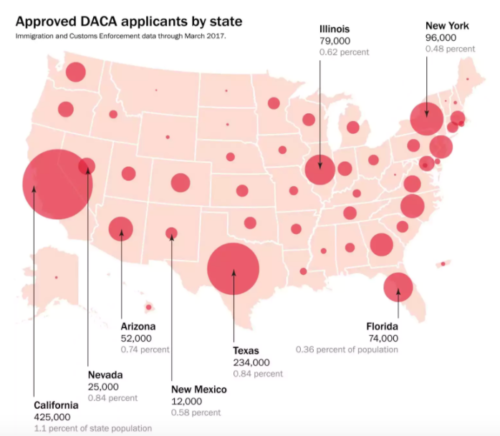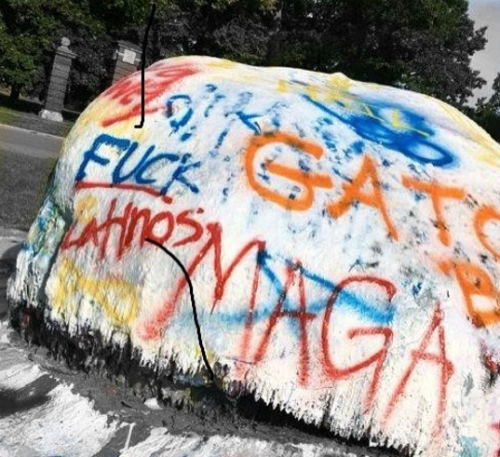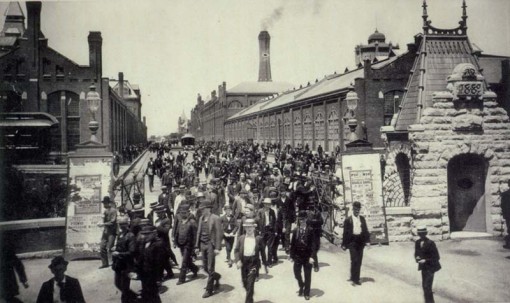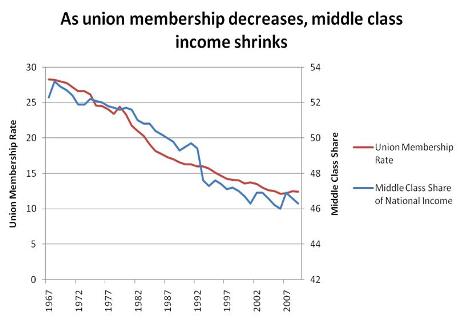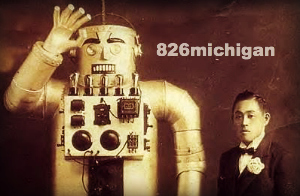Donald Trump is expected to announced tomorrow that he’s decided to kill the Obama administration immigration policy known as DACA (Deferred Action for Childhood Arrivals), which essentially allows those who immigrated to the United States illegally as children, to stay in the country without fear of deportation, so long as they continue to be good, contributing members of society, etc. [It’s actually more complicated than that, but that’s the gist of it. If you’d like to know more, you’ll find the specifics here.] While it’s expected that Trump will give Congress six months to come up with some kind of an alternative, assuming the repeal goes into effect, it could mean that the 787,580 people who registered to participate in the program, commonly referred to as “Dreamers,” could face deportation.
It should be noted that these young people came forward willingly, and in good faith, to announce themselves as undocumented immigrants, and register for this program that promised a path toward the American dream. On December 8, Trump, in a brief moment of lucidity, said the following of these young people. “We’re going to work something out that’s going to make people happy and proud,” he said, “They got brought here at a very young age, they’ve worked here, they’ve gone to school here. Some were good students. Some have wonderful jobs. And they’re in never-never land because they don’t know what’s going to happen.” Then, on January 18, just before taking office, Trump said that he was going to propose a plan with “a lot of heart” – one which would leave the Dreamers “very happy.” Well, I think it’s safe to say, that’s not what’s happening.
When asked why this should be a priority of our nation now, people on the far right talk of the societal costs associated with having these young immigrants in our country. Apparently, though, that’s not quite true. Not only are the coasts associated with having the Dreamers in the country relatively low, but the costs associated with deporting these individuals would be enormous. As the folks at the Washington Post point out, it will likely cost on the order of $8.5 billion to deport these Dreamers. That, as the Post points out, would be enough “to fund the National Endowment for the Arts (which Trump’s budget proposed eliminating) for 56 years,” or pay for “40 percent of Trump’s proposed border wall.” Furthermore, according to the conservative CATO Institute, “DACA rescission will cost employers $6.3 billion in employee turnover costs, including recruiting, hiring, and training 720,000 new employees.”
Really, it makes absolutely no sense, at least fiscally speaking. We’ve invested a great deal in these young people, most of whom, if I’m not mistaken, came here prior to starting kindergarten, and they’re just now beginning to contribute as tax-paying members of our society. Why push them out now? I mean, Apple alone, according to CEO Tim Cook, employs 250 Dreamers. Do we really want these people to return to Mexico and Asia, taking their talents, and their tax dollars, with them?
But I think we all know what this is really about. It’s about race, and the fear of a rapidly changing American demographic. Members of the far right, like Iowa Congressman Steve King, might say that this is all about restoring the “rule of law,” but it’s all about racial politics, and giving an easy victory to the far right of the Republicans party, like those who marched with torches through Charlottesville a few weeks ago. Dreamers are low-hanging fruit. Finding foreign-born criminals in America, and deporting them, is difficult work. Rounding up Dreamers, though, is easy. They’ve willingly told us who they are, and where they work. They played by the rules. And this, apparently, is how they repay them… Granted, Congress may take the hot potato that Trump just handed them, and do the right thing. Personally, I don’t think he cares. All he wants, I think, is for the far right to know that he’s doing his part to make America white again.
[above: A map showing where the DACA Dreamers are located, taken from the Washington Post article linked to above.]
For what it’s worth, not all Republicans are against DACA. According to a recent report in the Atlantic, allowing the Dreamers to stay is something most conservatives are OK with. “Nearly 80 percent of Republicans, and three-quarters of Trump voters, support it,” they say. But, they’re quick to add, “(I)mmigration hardliners like the pundit Ann Coulter, Breitbart, and Attorney General Jeff Sessions have been vocal proponents of ending the policy.”
As with the pardoning of racist Arizona sheriff Joe Arpaio last week, what we’re seeing here is Trump feeding raw meat to the most far-right members of his base, the people who conservatives in Congress truly fear, the most rabid nationalists and racists in America… This, it’s clear to me, is all about Trump preparing for battle over impeachment, and making sure the so-called deplorables are solidly behind him. There’s no other reason for this to be happening now, as we’re facing a nuclear showdown with North Korea. This isn’t about crafting good policy. This is about using the lives of nearly one million young people for political gain.
Unfortunately, as all of this is playing out in DC, we’re seeing signs of anti-immigrant sentiment here at home. In addition to the white supremacist literature found in Ypsilanti a few days ago, and recent incidents at the Ann Arbor Skate Park, and Concordia University, the “rock” on U-M’s campus, which had been painted by members of ALMA (Assisting Latinos to Maximize Achievement) to welcome new students to campus, was covered in pro-Trump and anti-immigrant graffiti.
[For more information about this most recent incident on the University of Michigan campus, see the La Casa (Latinx Alliance for Community Action Support and Advocacy) statement, and the response by U-M Chief Diversity Officer Robert Sellers.]
In a more perfect world, we would have a President leading our nation who, seeing this increasingly heated racial environment, would intercede and encourage us to be better people. Instead, though, we have someone looking to exacerbate the situation by adding fuel to the fire… Again, there is no reason why this had to happen now. This only serves to heighten tensions and push us closer to a breaking point. And, for what? So our President can look good to his far right base? So he has a bargaining chip to work with when trying to find the money to build his wall? It’s absolutely shameful. Using these young people in such a way is beyond disgusting. It’s just plain vile.
update: Jeff Sessions has made it official. The hot potato has officially been pitched to Congress.
Jeff Sessions announces the end of DACA pic.twitter.com/6smvfMkf3I
— Axios (@axios) September 5, 2017

